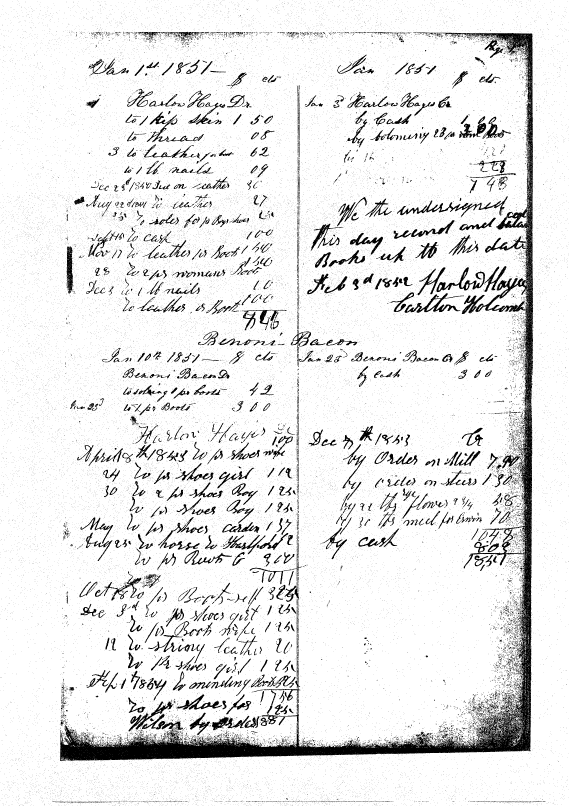|
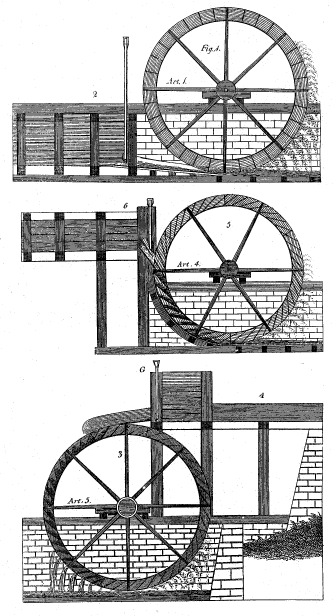
|
|

|
Return to home page. Contents
§ "A World Within Itself - an Introduction through Documents, Maps and Statistics" - this is a collection of material with which students begin to study Granby, Connecticut.
§ Chapter XLIX of Timothy Dwight's The History of Connecticut published in 1840.
§ "Windows into the Past" - a documentary collection on West Granby.
§ "Selected Population and Industrial Statistics" - a compendium of various statistics taken from the U.S.Census reports 1790-1860 and other reports.
§ "Heads of Families" - material from the manuscript U.S. Census returns listing people living in West Granby in 1820 and 1850.
§ Three Insurance Policies for carriagemakers' shops in West Granby (courtesy of the Salmon Brook Historical Society, Granby, Ct.).
§ A map collection showing the development of West Granby during the years preceding the Civil War.
§ A Contract between Levi Rice and Appleton Robbins for hats (courtesy of the Salmon Brook Historical Society, Granby, Ct.).
§ Two programs from the West Granby Academy (courtesy of the Salmon Brook Historical Society, Granby, Ct.).
§ An issue of the "Weekly News", a Granby newspaper from 1840 (Connecticut State Library)
§ Photographs showing various architectural styles in West Granby (courtesy of the Salmon Brook Historical Society, Granby, Ct.).
§ Selections from account books of Alpheus and Thaddeus Hayes, who operated a dye shop and cider distillery on Salmon Brook, Sheldon B. Hayes, who had a blacksmith shop, and Carlton Holcomb, a shoemaker (courtesy of the Salmon Brook Historical Society, Granby, Ct.).
This site was created by Mark Williams, a history teacher at The Loomis Chaffee School, Windsor, Connecticut, under a grant from the Connecticut Humanities Council. Some of the materials published here were originally created by Mark Williams as Connecticut Case Studies, under a grant from the Connecticut Humanities Council, and printed by the Hartford Steam Boiler Inspection and Insurance Company. John F. Sutherland of Manchester Community College, Ronald P. Dufour of Rhode Island College, Thomas P. Weinland of the University of Connecticut, Tracey Wilson of Conard High School, Robert K. Andrian of The Loomis Chaffee School, and State Historian Christopher Collier served as consultants. The Connecticut Humanities Council is the State Committee of the National Endowment for the Humanities. The viewpoints or recommendations expressed in the materials on this site of are not necessarily those of the Council or the Endowment. Teachers are encouraged to print and make copies of these materials for their students.
"A World Within Itself"
An Introduction through Documents, Maps, and Statistics Greenfield Hill
In 1794, Timothy Dwight, a teacher and soon to become President of Yale College, wrote a poem entitled "Greenfield Hill," in which he attempted to capture the spirit of Connecticut communities. The following are some selected lines from that poem. It might be helpful to know that Dwight, besides being a poet, was one of the most prominent Congregational theologians in Connecticut. Until 1818 in Connecticut, the Congregational Church was an established church which everyone was expected to attend and pay taxes to support, except for those who had acquired special certificates to attend and support other denominations. This religious establishment dated to the founding of the colony, when Puritans (the forerunners of the Congregationalists) viewed a town as merely the congregation doing its civil business. In the first line of the poem "train" means "people," and in the fifth "swain" means "young men."
How bless'd the sight of such a numerous train In such small limits, tasting every good Of competence, of independence, peace, And liberty unmingled; every house On its own ground, and every happy swain Beholding no superior, but the laws, And such as virtue, knowledge, useful life, And zeal, exerted for the public good, Have rais'd above the throng. For here, in truth, Not in pretence, man is esteem'd as man, Not here how rich, of what peculiar blood, Or office high; but of what genuine worth, What talents bright and useful, what good deeds, What piety to God, what love to man, The question is. . . . . Beneath their eye, And forming hand, in every hamlet, rose The nurturing school; in every village, smil'd The heav'n-inviting church, and every town A world within itself, with order, peace, And harmony, adjusted all its weal.This is a classic statement regarding the nature of Connecticut towns. Historians often consider such statements, which have a way of shaping the way we understand our past, against evidence gathered from intense studies of specific communities. See if you can put Dwight's poem into your own words. Then, as you read and study the following documents, maps and statistics, think about how closely Granby, Connecticut, a town on the northern edge of Hartford County, corresponds to Dwight's vision.
Granby, Connecticut A Town in the Foothills
The town of Granby, Connecticut is located approximately fifteen miles northwest of Hartford on the edge of the Berkshire foothills. Originally, this town was part of Simsbury, which was settled in the late 1600's by people from towns in the original "River Colony," in particular from the town of Windsor. Simsbury had two settlements from the beginning, one at Hopmeadow along the Farmington River, and another at "Salmon Brook," a more elevated meadow area between two branches of a tributary of the Farmington River. When the Connecticut Colony General Court established the town of Simsbury it assumed that it would be developed as a Puritan community with an established church, supported by a pious congregation that would see to it that the town's affairs were ordered according to the law of God.
During the early part of the 18th Century the town of Simsbury grew, and, as the threat of Indian raids diminished after 1720, the town granted out practically all of its domain to successive generations of Puritan farmers. People began to spread out, particularly into the hills on the western edge of town. Soon the settlers of Salmon Brook, along with settlers in some newly developed areas in Simsbury, complained that it was too difficult to attend church services and meetings in Hopmeadow and petitioned the colony legislature to set up separate "ecclesiastical societies," or parishes, each with its own church. After much dispute the General Court divided Simsbury in 1736.
Later in the century, the spirit of independence and home rule that characterized the time of the American Revolution also was present in the northern half of Simsbury. In fact, so independent-minded were these people that their delegate to the Connecticut convention to ratify the Constitution voted "no." The two parishes of Salmon Brook and Turkey Hills did not even trust the "distant" government of the selectmen in Simsbury and soon were demanding to be separated from Simsbury in "civil" as well as "ecclesiastical" affairs. Again, after much controversy, the state legislature of newly independent Connecticut granted their wish, and in October, 1786, those two parishes became the town of Granby (presumably named after the English military hero, the Marquis of Granby, or, perhaps, his son, also the Marquis of Granby, who was known for his opposition to taxation of the colonies when he served in Parliament).

General Descriptions
The following statements were taken from The Memorial History of Hartford County, J.Hammond Trumbull, ed. (Boston, Edward L. Osgood, 1886), pp. 81 and 229. They were written by two men who grew up in Granby in the 1800's.
Few communities have been less subject to change of inhabitants....Its lands are excellent and those who are engaged in agricultural pursuits have very much to encourage them to remain. Of the families shown on the map of ancient Simsbury to have been first settlers in this place, nearly all have descendants present and occupying the original homestead.
-Charles Horace Clark
Farming is the prevailing occupation of the people, the distance from good water power, as well as from railroad connections, rendering the place undesirable for manufacturing purposes.
-William Scoville Case
An Early Town Meeting
These resolutions were recorded in the Granby Town Records as being passed by the town meeting of October 10, 1803. They were passed in response to an act of the state legislature which traded away a part of the town of Granby (the little notch at the top center of present-day Connecticut) to Massachusetts. This was a result of a settlement in a long dispute between Connecticut and Massachusetts over a misunderstanding about the location of the boundary between the two states.
Resolved, as the sence of this meeting that the act of the General Assembly at the Session of May last respecting the cession of part of this town to the Commonwealth of Massachusetts do matearally effect the Rights and in the opinion of this meeting is a ferious injury to the town in its Corporate Capacity & more especially to the Eclesiastical Society which by the opperation of said act is severd & perhaps broken up.
. . . still we hold our Special Right as freeman to inquire wheather the ordinary Legislature of the State are vested with Constitutional powers to ceed a part of the Territory of this State so as to Place the Citizens living within the limits of the Ceded Tract under any Foreign Jurisdiction than by subjecting them to Laws and Customs to them unknown and without their consent depriving them of their inestimable Jurisdiction civil and religious under which they were born and educated & to support which they have ever cherefully contributed their full purportion of the publick Burthens.
Comparative Population Statistics
Census
Granby
Hartford
Connecticut
United States
1790
2595
4090
238,141
3.9 million
1800
2735
5329
251,002
5.3 million
1810
2696
6003
262,042
7.2 million
1820
3012
6901
275,202
9.6 million
1830
2722
9789
297,675
12.9 million
1840
2611
12,793
309,978
17.1 million
1850
2498
17,966
370,792
23.2 million
1860
2553
30,448
460,147
31.4 million
A Look at the Town Leaders
The following table gives some information about men who held the most important offices in town government before the Civil War. The United States Censuses of 1850 and 1860 give statistics regarding the value of land and houses owned by individuals in the town of Granby. From the town records it is possible to determine what individuals ever held the office of selectman, representative to the General Assembly, captain of the town militia, or town clerk. In 1850 there were 78 such men, and in 1860 there were 58. The table shows how much of the town's real estate was owned by its political leaders.
Census
Total Real Estate Value
% of Total owned by all Leaders of Town
Number of Leaders
Average per Leader
1850
$353,025
80
78
$4526
1860
$297,410
74
58
$5128
Return to contents.
Chapter XLIX of Timothy Dwight's
The History of Connecticut
from the First Settlement
to the Present Time
Published in 1840
Windows into the Past
Selections from Documents on Granby
This collection of materials contains brief selections from various documents that relate to West Granby between 1810 and 1845. Each selection, by itself, does not provide a great deal of information about West Granby, but all together, and combined with other sources in this package, they begin to tell a story of what life was like for people at that time. Look, in particular, for evidence of changes that people were experiencing and of the forces behind those changes.
The Preacher and the Innkeeper
Like all towns in Connecticut, Granby had an established church. In fact, within the town's bounds there were two "ecclesiastical societies," or parishes, of Connecticut's Congregational church. Not everyone within a society was a member of the church, but, between the Revolution and 1818 persons who did not attend church meetings and pay taxes for support of the minister (the "society rate") either had to have a certificate from another church they were attending or were subject to fines for absence. Being admitted as a member of the church (the Congregation voted to accept new members based on "professions of faith") carried with it special privileges and a certain degree of status in town affairs as well.
The western society of Granby, the Salmon Brook Society, underwent some difficulty and disorganization in the years following the Revolution, but in 1794 the "Prudential Committee" found a minister, Isaac Porter, who would prove to be a strong leader. Porter was a stern Puritan, deeply concerned with "church disciplyne." He served from 1794 until 1832, when he was ignominiously dismissed by the Congregation for his outdated notions (in 1818 Connecticut disestablished the Congregational church, but Porter continued to charge people for absence anyway). The following is an excerpt from a sermon he gave sometime around 1814, a time when many Congregational preachers were trying to "revive" religion in New England with emotional speeches and special prayer meetings.
There is no possible way for those to escape everlasting punishment who neglect this gospel salvation....Those who neglect this salvation which Christ has by his suffering and death purchased for them are guilty of the blackest ingratitude towards him....It proves to a demonstration the moral deprivation of the human heart &emdash; Mankind are in a great measure insensible of their situation: they are insensible of the importance of closing in with the offers of salvation they have not the least vestage of holiness remaining in them: they are spiritually dead: as the scriptures inform us they are dead in trespasses and sins &emdash; Eyes have they but they see not ears have they but they hear not and their foolish hearts are darkened &emdash; If mankind were once to see the awful situation in which they are by nature; were they to be sensible of the perishing need in which they stand of a saviour they would cease to be guilty of that stupidity and negligence towards religion they now are.
On May 5, 1815, according to Isaac Porter's records of the church, the deacons, probably at Porter's request, made various charges against one James Huggins, of West Granby, demanding that he apologize and repent or be excommunicated from the church (lose his standing as a member). Huggins was a prominent man in Granby. He had moved to town after the Revolution and established a prosperous business as a miller, innkeeper, and shop owner on Salmon Brook in West Granby. Admitted to the church in 1792, he had been on the committee that had hired Isaac Porter in 1794. In town politics he was a spokesman for the people who wanted to see the western part of town developed rapidly, and thus argued often for expenditures on improvements of town roads in that area. He had served as selectman, town agent and representative to the General Assembly. After the War of 1812, however, his business began to decline, partly because of unwillingness of the town to improve the roads, partly because Rev. Porter was on a campaign to abolish "ardent spirits" from Granby (Huggins had a gin distillery and continued to operate his tavern), partly because of a flood that destroyed most of his buildings, and generally because of the economic decline the War had brought about in New England. The charges leveled against him reveal his state of mind at the time, as he responded to Porter's temperance movement, and generally, to the decline of his fortunes:
[He was charged with] an irreverent and profane us of God's name, &emdash; of slight, reproachful and contemptuous expressions concerning the Holy Scriptures, &emdash; of discouraging extraordinary meetings for religious exercises, &emdash; of neglecting the public worship of God, and the ordinances of the Gospel, &emdash; And of uncharitable expressions and insinuations against the accredited Ministers of the Gospel, tending to destroy their influence and usefulness.
Huggins was brought to "trial" before the Congregation, which eventually voted to excommunicate him, although they instructed Porter to try to "reclaim" him before actually making the decision public. This extract from Porter's records describes Huggins "defense" at his trial. (Note: the meetinghouse where the church met was about two miles east of the village of West Granby where Huggins lived.)
Huggins' speech was lengthy and for the most part wholly foreign from the case, consisting in a detailed history of the rise and progress of persecution from the days of Cain and Abel down to the present time, including a minute account of the proceedings of the Court of inquisition &emdash; their horrible injustice and cruelty & c &emdash; He alleged that our forefathers of this land brought the same persecuting spirit with them which has been handed down from generation to generation to this present time, and that wee (evidently meaning this church) were a branch of the inquisition providing with the same spirit, And concluded by asserting that it was Malice and hatred which had produced the charges against him and brought him to answer to them before the Church &emdash; except this, he only objected in excuse for nonattendance on the worship & ordinances of the Gospel, that the doctrines preached were not the gospel, i.e. good views & c &emdash; and the inconveniences of attending & c.
In December of 1815, after he was excommunicated, Huggins was elected to be one of the town's representatives to the General Assembly. He died in 1819, deep in debt. It may seem odd that Huggins was respected enough to be elected to such a high post, even though he was nearly destitute and cast out by the church. What sorts of inferences can we make about changes this community was experiencing?
From a West Granby Account Book
The following selections were entries made in the back of a 1795 general store ledger that, apparently, was owned by someone in the Hayes family living in West Granby in the early 1800's.
1811
Sept 9th Samuel Jones Junr setout for New connecticut. good weather
Oct. 23 rainy 25th snowy & cold 31st heavy rain
1815
August 3 rain 8th do 30 rain Sept 9th rain 16th rain 23rd the greatest Flood I known for many years carrying away Bridges fences and the like and did much damage to the roads meadows &c
August 28th 1826 the great Flood which swept away sawmills Gristmills Silas Cones Blacksmith shop tan works Clothier's works Roads fences Bridges did a great deal of damag to the Crops
Maria left home for Pompey New York Oct. the 5 1826
Bildad Kendal's twins born and died July 13th, 1831
Samuel J. Hayes found a Bee tree south of Ovil Willcox and south of the Great falls on the 30th day of June 1826 and marked the letters S J H in sd tree in three places
Samuel J. Hayes
Granby
June 30th 1826
A Young Man Writes Home
The following excerpt is from a letter from Henry Goddard at Troy Grove, Illinois to his father, Isaac Goddard, of West Granby, May 12, 1838.
I do not think that you could stay there in old Connecticut a great while if you knew what a beautiful Country this is it is such a good place for young people to get a start in the world. I think that the girls would do well at their trade here, for good sewers are sparse in this country.
A New Religious Society
Even though Granby had an established church, there were other religious denominations before the new Constitution of 1818 gave them equal standing with the Congregationalists. The Congregational meetinghouse was located at the geographical center of town, about two miles east of the village of West Granby. In West Granby a Methodist Society had formed as early as 1799, but, apparently did not attract great numbers (probably because the Congregational leaders, many of whom lived in West Granby, made it difficult for them to exercise their certificate rights). Methodism offered an alternative to the less optimistic Puritan doctrines and was also a simpler version of the more ritualistic Episcopalian (formerly Church of England) faith. In 1844 a new Methodist Society formed in West Granby, adopting the following resolution. The meetinghouse was eventually constructed almost opposite the house of Silas Cone.
We the citizens of West Granby and vicinity feeling the importance of having a house of public worship and believing that the worship of Almighty God is due from Every rational and intelligent being and calculated to promote the interest of any community. Therefore We the subscribers for the consideration of having a meeting house built in West Granby for the Methodist Episcopal Church and Society agree and promise to pay unto the Trustees of Sd. Society (hereafter to be appointed by Sd. Society) the Sums annexed to our several names Respectively for the purpose of building a house as aforesaid and the house when built shall be under the controls of the Trustees of Sd. Society and located Somewhere between the house of Silas Cone and the house of Sylvester Parmelee in the village of West Granby one half of the Subscription to be paid on the first day of June 1844 and the remainder to be paid when the house is finished. The coarse materials for Sd. house to be set up in lots to the lowest bidder
West Granby Feb 28th 1844
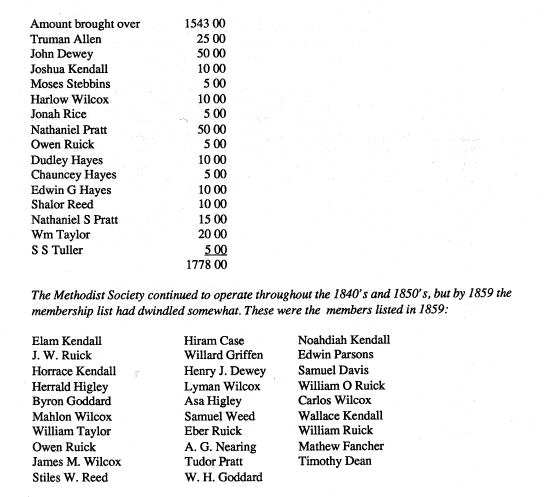
From the Diary of Adelaide Holcomb
Adelaide Holcomb was born in Granby in 1838, and lived in one of the farms not far from the village of West Granby. Her diary of 1864, when she was still unmarried and living with her parents, reveals a great deal about a young woman's life at the time.
Tuesday, March 8: Washed - and the clothes dried nicely - I have been reading some in the "life of Charlotte Bronte" and have partly written two letters. We have been out to Rev. Scofields to sing - kept chin up until after eleven o'clock had a very pleasant time - if it was a little muddy. Starr sung to me going out - one of John's tunes.
Thursday, March 10: Baked - Mother has been out to Aunt Eunice's. I have finished the 1st Vol. of Charlotte Bronte's life. Oh dear! If a woman wishes to escape the stigma of husband seeking they must act & look like marble or clay - cold expressionless - bloodless - for every appearance of feeling of joy, sorrow admiration or disgust - are alike construed by the world into an attempt to hook a husband Never mind well-meaning women have their own conscience to confuse them after all.
Saturday, March 19: I can hardly tell how time gets on at Granby Old Diary. There is no event to mark its progress. One day resembles another and all have heavy, lifeless physiognomies. Sunday and Monday are the only ones that have any distinct mark. Meantime life wears away - I'm so old - and as yet have done nothing. Sometimes I get blue at the prospect before & behind. Yet it is wrong and foolish to repine. Undoubtedly my duty directs me to stay at home for the present. I feel as if I was buried here. I long to work or live a life of action - that will be appreciated to be independent of friends. I have been to singing school this evening.
Sunday, March 20: Attended Church all day at West Granby. Had a very full and pleasant SS the 15th Chap. 1st Cor. was our lesson. Evening attended singing school. Estelle & I sang a solo as Mr. Fuller requested us to do so. George Gaines was to singing school but I didn't get a chance to speak with him.
Saturday, April 30: I have been baking nearly all day - hope I shall some day be able to write something besides I've ironed - baked or washed - I have very little time to sew. Uncle John was here to dinner - Hubert is much better. I have called on Mrs. E. and Colestia - She seems much as she did when I was with her.
Tuesday, July 12: Washed - baked - &c. &c.
Sunday, July 24: Attended church at West Granby all day - at noon went to Uncle Nahum's - Fannie was home & we had a good time eating dinner &c. - Evening attended singing school after recess - down to Dr. Wilcox's and made them quite a visit - Fannie and Willie called to see us after tea. I had a long talk after I got home and it was early when I got to bed.
Return to contents.
Selected Population and Industrial Statistics
Table 1: Occupational Distribution in Granby (% of Heads of Family)
Census
% in "Manufactures and Trades"
% in "Agriculture"
1820
10.1
67.8
1840
14.1
73.3
1850
26.2
56.4
1860
23.0
56.4
Tables 2, 3, and 4 have to do with the concept of population turnover. Historians will look at population turnover to determine how much change an area is experiencing. In some cases it is possible to determine the turnover from year to year, by adding the percentage of the total population that is new in a given year to the percentage of the population that was there the previous year, but has left. Thus a 200% turnover rate would mean everybody in the population was new - all the people from the previous year had left. In the case of rural areas like Granby, where lists of people in the community were made only every ten years by the U.S. Census, it is not possible to arrive at a yearly turnover figure. However, the turnover in Granby's population every ten years is still revealing.
Table 2: Heads of Family Turnover (in %)
Census
names subtracted from
+ names added to
=total turnover
1790-1800
58.4
59.7
118.1
1800-1810
63.6
57.8
121.4
1810-1820
49.4
58.3
107.7
1820-1830
60.6
52.9
113.5
1830-1840
51.8
64.0
115.8
1840-1850
58.9
56.5
115.4
1850-1860
58.1
55.4
114.5
Table 3: Permanent and Impermanent Residents (in %)
In order to understand the nature of the turnover illustrated in Table 2, Table 3 looks at the individuals who seemed to be staying in Granby for the shortest period of time (that is, people who were listed on only one or two of the censuses between 1790 and 1860, as opposed to people whose names showed up on three or more of the censuses). What percentage of the total population were these relatively impermanent people? Once we know that we can decide if the turnover given in Table 2 is a result of general movement of people in and out, or if the population is divided between those who stay a long time and those who stay a short time.
Census Year
Heads of Family Listed Once Only
Heads of Family Listed Once or Twice
Heads of Family Listed Three or More Times
1800
29.9
48.5
51.5
1810
33.9
51.2
48.8
1820
26.8
51.4
48.6
1830
28.7
51.6
48.4
1840
34.5
57.9
42.1
1850
35.0
56.1
43.9
Table 4: Permanence and Different Occupations
Finally, we could look at the occupations of those who seem to be less permanent members of Granby's population. Put this information together with impressions you get from the Heads of Family listings and the overall occupational statistics in Table 1. Do there seem to be differences among various groups according to occupation and permanence? From what group do you suppose the historians quoted in the introduction to this package come?
Census
% of those employed in manufactures and trades which are listed once only
% of those employed in agriculture which are listed once only
1820
45
22
1840
49
27
1850
56
24
Products
The following excerpts come from the 1819 Gazetteer of Connecticut and Rhode Island. It should be noted that the eastern section of Granby noted below was the parish of Turkey Hills, which separated with the Salmon Brook Society to form the town of Granby in 1786. The Turkey Hills parish had hoped to have its own town and continued to press for separation until 1858 when the town of East Granby was incorporated.
[The township of Granby] is characterized by a diversity of features, which are strikingly various; towards its eastern section, the green stone mountain ranges through it from north to south; this mountain here is perhaps more elevated than at any other place in the State, and its characteristic features more conspicuous, particularly in the vicinity of the State prison [Old Newgate Prison now in East Granby]. Its western declivity, for a considerable distance from its summit, is nearly a perpendicular precipice, and its rocks are naked, and exhibited in disordered fragments. From this range of mountain, to near the eastern border of the township, the surface has a declivity to the east. This section of the town is a valuable agricultural district; the soil is a rich gravelly loam, generally warm and fertile, well adapted to orcharding, grain or grass. Immediately west of the mountain, the face of the country is hilly, and in some instances, ledgy; but the lands, though hard and stony, are fertile, and well adapted to grain and orcharding. West of this district, there is an extensive tract of plain, the soil of which is generally a light sandy loam. This tract is intersected by Salmon brook, a pleasant and lively mill stream, and extends for a considerable distance west of this stream. The lands here are well adapted to rye, and afford also good orcharding. West of this tract, and towards the extreme western border of the town, it is hilly and mountainous; the lands are rough and stoney, and the soil hard, cold and gravelly. This section of the town, bordering upon Hartland and Barkhamsted, comprises the eastern extremity of the granite range of mountain, which extends through those towns. the natural growth here is oak, maple, beach and some hemlock; upon the tract of plains east of this it is oak and yellow pine; upon the green stone range, and the district east and west of it, the timber is oak, walnut, chestnut, &c.
. . . . The population of the town, at the last census, was 2683; and there are 380 dwelling houses, 4 companies of militia, and about 400 qualified Electors. There are two Card Factories, two Wire Factories, one Powder Mill, six Grain Mills, two Fulling Mills, three Carding Machines, three Tanneries, and four Mercantile Stores.
There are two small Social Libraries, two Clergymen, four Physicians, and four Attorneys.
The following excerpt is from Statistics of the Condition and Products of Certain Branches of Industry in Connecticut written by Daniel P. Tyler in 1846. Tyler was Connecticut's Secretary of the State and prepared his material from returns of local assessors.
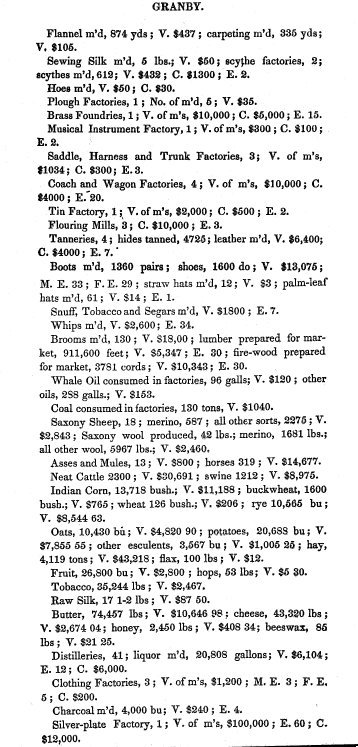
Heads of Families
Every ten years the government of the United States takes a census of the population. Initially this provision in the Constitution was made to determine how many representatives each state would be allowed in Congress. However, Congress soon saw the census as a good opportunity to collect different kinds of information on the changing population of the United States. Thus, it ordered the census marshals to note the names of the family heads as they proceeded through their respective districts, as well as listing family members in different age groups and occupational categories. This information is valuable to historians, particularly when dealing with towns such as Granby which did not keep extensive records itself (perhaps because the town clerk, himself, was too busy trying to make a living to engage in the record-keeping). The following lists are taken from the manuscript census returns that are kept in the Connecticut State Library, and constitute those people living in the village of West Granby. There were also many outlying farms around the village center, and those farmers considered themselves part of West Granby, but they have not been listed here. What can you tell from these lists about life in West Granby in the early 1800's? How did these people make a living? What were their families like? How did they differ from each other? What do you think their principal concerns and aspirations would be?
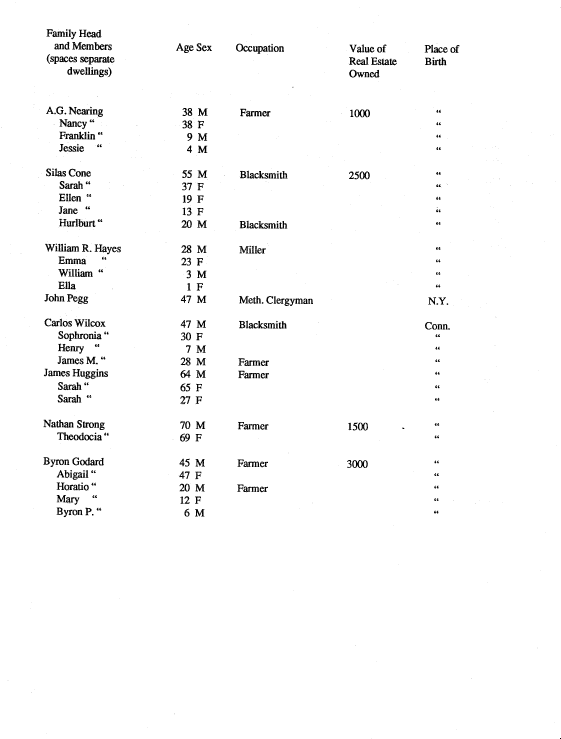
Three Insurance Policies for Businesses in West Granby
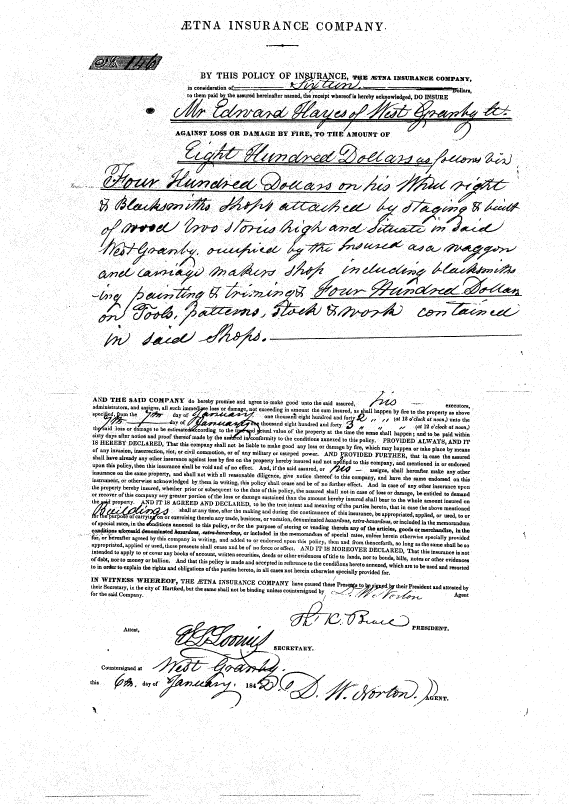
Maps of West Granby, 1810-1869

A Contract between Two Businessmen
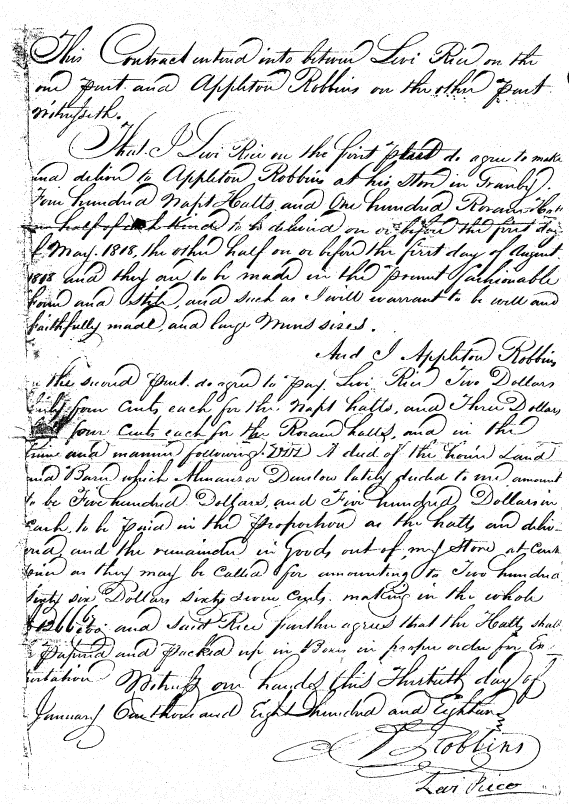
Commencement Programs for the West Granby Academy
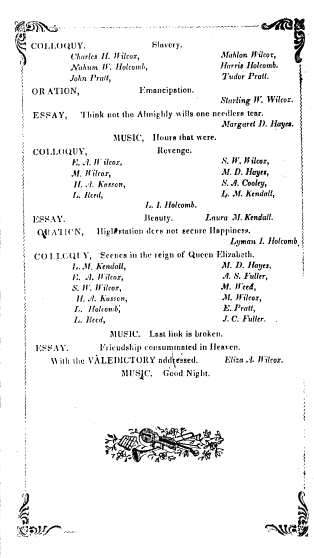
A Local Newspaper
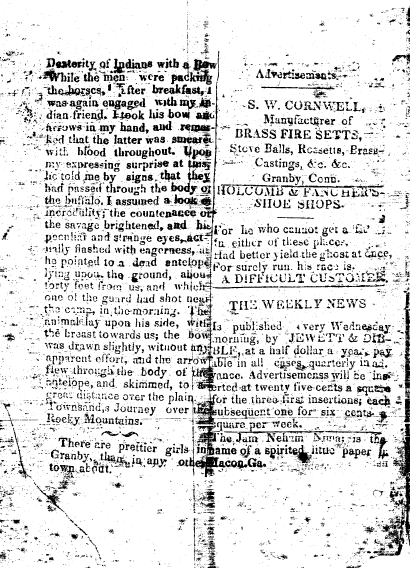
Photograph Collection showing Scenes of West Granby as the village appeared sometime between 1880 and 1910
(Courtesy of the Salmon Brook Historical Society, Granby, Ct.)
The attached pages are taken from three account books of tradesmen who lived and worked in West Granby, Connecticut. The first selection is from the ledger of Thaddeus and Alpheus Hayes, two brothers who ran a cloth and dye shop, and later a cider mill and distillery on Salmon Brook from about 1795 until Alpheus's death in 1828. Alpheus's son George took over the clothier business after that, and another son, Edward, converted the cider mill into a carriage manufacturing shop. Edward was bankrupt by 1840 and migrated to Pennsylvania where he did better in the same business.
A second set of pages comes from the account book of Sheldon B. Hayes, a blacksmith and wheel maker who practiced his trade on the north end of the village area between 1815 and the 1830's. He was Alpheus and Thaddeus Hayes's brother, all sons of Benjamin Hayes.
The final selection comes from the account book of Carlton Holcomb, a shoemaker who moved to West Granby from another part of Granby around 1844. He had been trained by Truman Allen who ran a large shoemaking operation that marketed its products in a number of states in the northeast. Carlton may have had similar ambitions, but his shop never did expand beyond a few employees. He built his house in 1845, the year before his marriage to Eliza Ann Wilcox, a local farmer's daughter. He lived in West Granby until his death in 1895.
(All pages are copies of account books held at the Salmon Brook Historical Society, Granby, Ct.)
